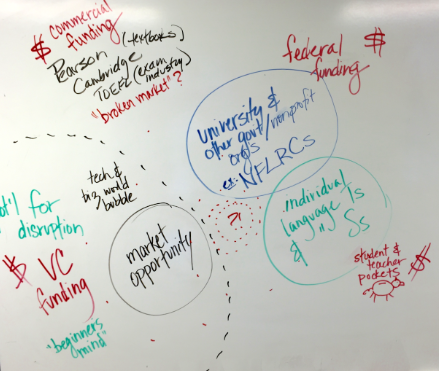Here is a brief article I wrote for the CASLS Intercom newsletter, released March 2, 2020. Subscribe to Intercom here, a must for language learning professionals.
The winds are favorable for the field of language education, with more than 777 language startups, a single app with more than 300 million users, and an online language learning market projected to grow by 18.61bn in the next four years. We should be suspicious about the commodification of language learning, and the proliferation of deceiving “magic pill” disruptors, but the truth is that none of us work for free as language professionals. What are we doing to make sure these resources are not wasted, positioning ourselves at the helm of our field for formal and informal learners who want to maintain and speak new languages? Higher education enrollments are declining and language learners are not in the business of giving language teachers work.
It is not a coincidence that the Center for Applied Second Language Studies (CASLS) at the University of Oregon asked me to write this piece. They are setting the pace for meaningful collaborations between academia and industry players and together we are planting the seeds of a Community of Practice for strengthened intersections between Instructed Second Language Acquisition, user-experience design, and product development. Millions of users are subscribing to language apps, but they often obtain disappointing results. We understand language development as a wicked humanitarian problem and our goal is to promote transformative tools, spaces, products, and tech jobs that address the complexity of learning a language, in other words, a new way of being in the word.
What I like about CASLS is not different from what I like about many intrapreneurs that I have interviewed in the last 10 years. They are thinkers and doers, critical innovators like that group of instructors at Princeton who created their own Spanish textbook, breaking up with an industry that benefits from a broken market. When I talked to them, I felt agency, a special and contagious energy such as the one that Joan Bajorek infuses in Women in Voice. Joan left a promising career in academia for a job in the tech industry and is now a role model for any applied linguist who is not seduced by the tenure-track path. And back to higher ed, recently two language professors at Yale started a course entitled Languages in Dialogue, blending Arabic and Hebrew. As challenging as it seems, one can only hope to see more multilingual initiatives such as this one, since the world outside of the classroom is rarely monolingual.
We face, indeed, a time for the language field to reconsider its relationship with innovation. The winds are more favorable than we think.

Gabriel Guillen (PhD) is a Professor and the Director of the Summer Intensive Language Program at the Middlebury Institute of International Studies (MIIS). At MIIS, Gabriel teaches content-based language courses such as Spanish Social Entrepreneurship, Spanish Fake News, Spanish Digital Projects, Spanish Talks for Social Change, and Spanish in the Community, connecting his students with English learners in the Salinas Valley, California. With Robert Blake, he recently published Brave New Digital Classroom (2020), an overview on key concepts and challenges of teaching and learning languages with technology, with a new focus on social CALL (Computer-Assisted Language Learning). With Julie Sykes and Christopher Daradics from CASLS, and Thor Sawin from MIIS, Gabriel will be hosting the panel Mavericks of Mind: A Followup Report on Social CALL for Language and Technology Professionals at CALICO 2020.